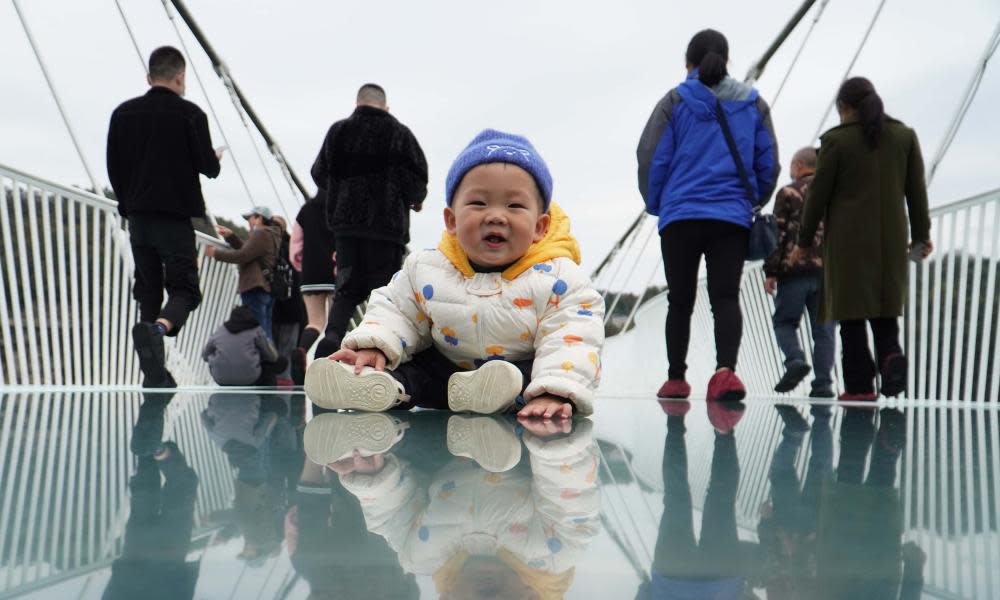China’s population growth rate falls to 61-year low

China’s population growth rate has fallen to its lowest level in six decades, barely outnumbering deaths in 2021 despite major government efforts to increase population growth and stave off a demographic crisis.
Across China, 10.62 million babies were born in 2021, a rate of 7.52 per thousand people, the national bureau of statistics said on Monday. In the same period 10.14 million deaths were recorded, a mortality rate of 7.18 per thousand, producing a population growth rate of just 0.34 per thousand head of population.
The rate of growth is the lowest since 1960, and adds to the findings of last May’s once-a-decade census, which found an average annual rise of 0.53%, down from 0.57% reported from 2000 to 2010.
China, like much of east Asia, is in the grip of a population crisis, with lowering birthrates, and predictions of imminent negative population growth and an ageing population. Monday’s figures showed the proportion of over-60s in China rose from 18.7% in 2020 to 18.9%.
Related: Chinese dialects in decline as government enforces Mandarin
“The demographic challenge is well known but the speed of population ageing is clearly faster than expected,” said Zhiwei Zhang, the chief economist at Pinpoint Asset Management.
“This suggests China’s total population may have reached its peak in 2021. It also indicates China’s potential growth is likely slowing faster than expected.”
Beijing has announced major reforms to address the decline, including raising the retirement age. A three-child policy has replaced the two-child policy that was introduced in 2016 and had sparked a slight increase in births before falling again.
The high cost of living, delayed marriages and lack of social mobility are frequently cited as contributing factors to young Chinese people’s reluctance to have children. In response, Beijing has banned expensive private tutoring, and pledged better access to childcare and maternity leave.
Prof Wang Feng, from the University of California Irvine and who specialises in Asian demographics, said the results showed the root causes ran deeper than the policymakers realised.
“The policies announced last year are mostly rhetoric, or at most like Band-Aids,” he told the Guardian.
“Without addressing the deeply rooted causes discouraging young Chinese from getting married and having children, from gender inequality to high living cost, what we are seeing now is likely just the beginning of a further decline in birthrate and a prolonged process of population decline in China.”
China also faces potential instability on the economic front, with GDP data published alongside the population findings revealing a dramatic slowdown in the final months of 2021.
China, the world’s second-largest economy, reported a higher-than-expected GDP rise of 8.1% year-on-year, beyond the government’s predictions of 6%, but with the growth concentrated in the first half of the year. In the fourth quarter it rose by 4%, down from 4.9% in the third quarter.
Related: From economic miracle to mirage – will China’s GDP ever overtake the US?
“The domestic economy is under the triple pressures of demand contraction, supply shock and weakening expectations,” said bureau spokesman Ning Jizhe.
The last year has seen extraordinary levels of change in consumer habits and of government intervention in major Chinese industries. Retail sales growth dropped from 3.9% in November to 1.7% in December.
“Economic growth is clearly under pressure, (and) recent Omicron outbreaks in China exacerbated the downside risk,” said Zhang.
Construction has slumped and property sales were battered amid a crisis in development, most notably the ongoing financial difficulties of major firm Evergrande.
Government intervention into the $1bn private tutoring industry and continued crackdowns on the tech sector have also seen waves of layoffs. An emissions-reduction push coupled with supply chain issues and bans on some imported coal have been blamed, alongside rising power prices for power cuts.
The headline and first paragraph of this story were amended on 17 January 2022. The original said China’s birthrate had dropped to the lowest level in six decades. It is actually the population growth rate that is at a six-decade low. The birthrate is at the lowest since 1949.

 Yahoo Movies
Yahoo Movies 
